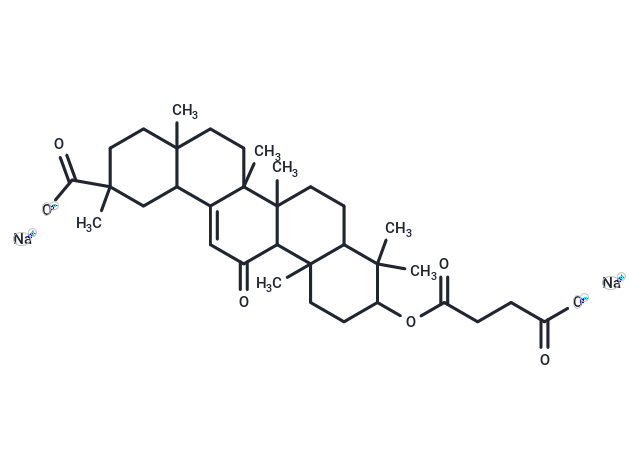Shopping Cart
Remove All Your shopping cart is currently empty
Your shopping cart is currently empty
Carbenoxolone disodium (Duogastrone) salt is an agent derived from licorice root. It is used for the treatment of digestive tract ulcers, especially in the stomach. Antidiuretic side effects are frequent, but otherwise, the drug is low in toxicity.

| Pack Size | Price | USA Warehouse | Global Warehouse | Quantity |
|---|---|---|---|---|
| 10 mg | $30 | In Stock | In Stock | |
| 25 mg | $64 | In Stock | In Stock | |
| 50 mg | $97 | In Stock | In Stock | |
| 100 mg | $163 | In Stock | In Stock | |
| 500 mg | $397 | - | In Stock | |
| 1 mL x 10 mM (in DMSO) | $57 | In Stock | In Stock |
| Description | Carbenoxolone disodium (Duogastrone) salt is an agent derived from licorice root. It is used for the treatment of digestive tract ulcers, especially in the stomach. Antidiuretic side effects are frequent, but otherwise, the drug is low in toxicity. |
| Synonyms | Duogastrone, Bioral, Biogastrone |
| Molecular Weight | 614.72 |
| Formula | C34H48Na2O7 |
| Cas No. | 7421-40-1 |
| Smiles | [Na+].[Na+].CC1(C)C(CCC2(C)C1CCC1(C)C2C(=O)C=C2C3CC(C)(CCC3(C)CCC12C)C([O-])=O)OC(=O)CCC([O-])=O |
| Relative Density. | no data available |
| Storage | Powder: -20°C for 3 years | In solvent: -80°C for 1 year | Shipping with blue ice/Shipping at ambient temperature. | ||||||||||||||||||||||||||||||||||||||||
| Solubility Information | H2O: 162.7 mM, Sonication is recommended. DMSO: 13.75 mg/mL (22.37 mM), Sonication is recommended. | ||||||||||||||||||||||||||||||||||||||||
| In Vivo Formulation | 10% DMSO+40% PEG300+5% Tween 80+45% Saline: 1 mg/mL (1.63 mM), Sonication is recommended. Please add the solvents sequentially, clarifying the solution as much as possible before adding the next one. Dissolve by heating and/or sonication if necessary. Working solution is recommended to be prepared and used immediately. The formulation provided above is for reference purposes only. In vivo formulations may vary and should be modified based on specific experimental conditions. | ||||||||||||||||||||||||||||||||||||||||
Solution Preparation Table | |||||||||||||||||||||||||||||||||||||||||
DMSO/H2O
H2O
| |||||||||||||||||||||||||||||||||||||||||
| Size | Quantity | Unit Price | Amount | Operation |
|---|

Copyright © 2015-2025 TargetMol Chemicals Inc. All Rights Reserved.